Using Spells to Maintain Battlefield Control
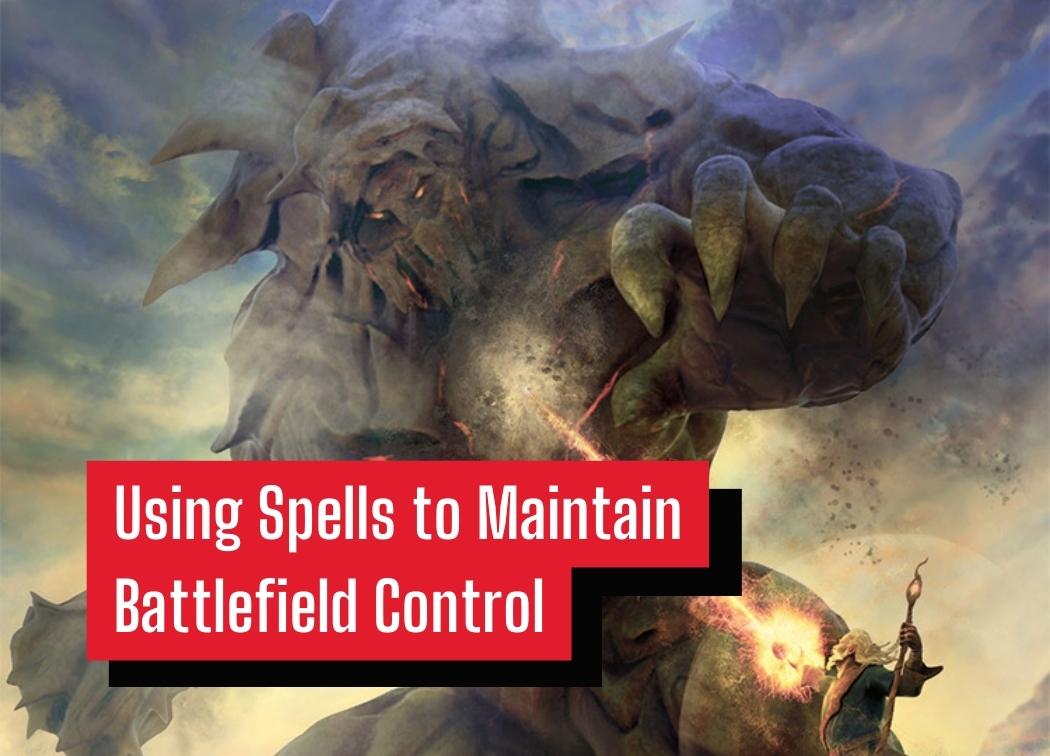
Battlefield control is an important factor in beating an encounter in D&D 5e or any TTRPG for that matter. Preventing an enemy from attacking your allies or forcing them to waste precious time trudging through difficult terrain is a welcome advantage for the party to have in an encounter.
Controlling the battlefield is a job that is difficult to put any sort of statistical weight into. Plus, it’s by no means as flashy or exciting as dealing a truckload of damage to an enemy is for most people.
It’s easy to calculate and visualize how dealing massive amounts of damage to an enemy is a tangible benefit to the party’s success in a combat encounter. It’s difficult to calculate the benefits that throwing up a wall of ice between yourself and the enemy.
However, preventing an enemy from reaching the party or giving yourself and your allies more opportunistic positioning is an enormous benefit that you can provide the group. While anyone can assist in controlling the battlefield, spellcasters in 5e certainly have the widest variety of tools to get the job done.
Today we’re going to focus on two types of spells that assist with battlefield control, walls and AoE control spells.
What is Battlefield Control?
I’ve previously mentioned battlefield control in two articles. The first with regards to how creature size gives larger creatures the innate benefit of controlling more space on the playing field, ergo, more battlefield control. The second was about how gaining an elevation advantage is also beneficial in an encounter.
Simply put, battlefield control is the concept of “owning” a portion of the battlefield. This area can be considered a safe space for you and your allies to either fall back or push into. It’s your territory and the enemy is at a tactical disadvantage when they enter it.
The enemy also has territory during an encounter. A key factor in controlling the battlefield is finding opportunities to claim the enemy’s territory. This can be as simple as slaying an enemy, grappling them, or forcing them out of their position in any other manner.
Today, we’re going to talk about how you can use spells lock down portions of the enemy’s territory to dictate where the enemy is capable of moving. While the spells I’m going to mention all have the benefit of also dealing damage to the opponent even a spell such as Grease can get the job done.
Examples of Battlefield Control
Using AoE Control Spells Like Spike Growth
AoE control spells, as the name implies, are spells that change or impact a portion of the environment. These are typical spells that spread out from a specific square of the battlefield that you choose. This area is now your territory as it is an advantageous position for you to force the enemy to travel through.
Spike Growth is a low-level druid and ranger spell that conjures a mess of disguised thorns and spikes on top of a chosen location. These spikes and thorns are spread around a 20 ft. radius which is quite a sizeable amount of space that is now effectively controlled by you.
If an enemy chooses to walk through this space they will take 2d4 piercing damage for each 5ft space they travel through. Plus, this area is considered to be difficult terrain. If an enemy, knowingly or otherwise, walks through this section of your territory they will be put at an extreme disadvantage.
Apply Directly to the Enemy
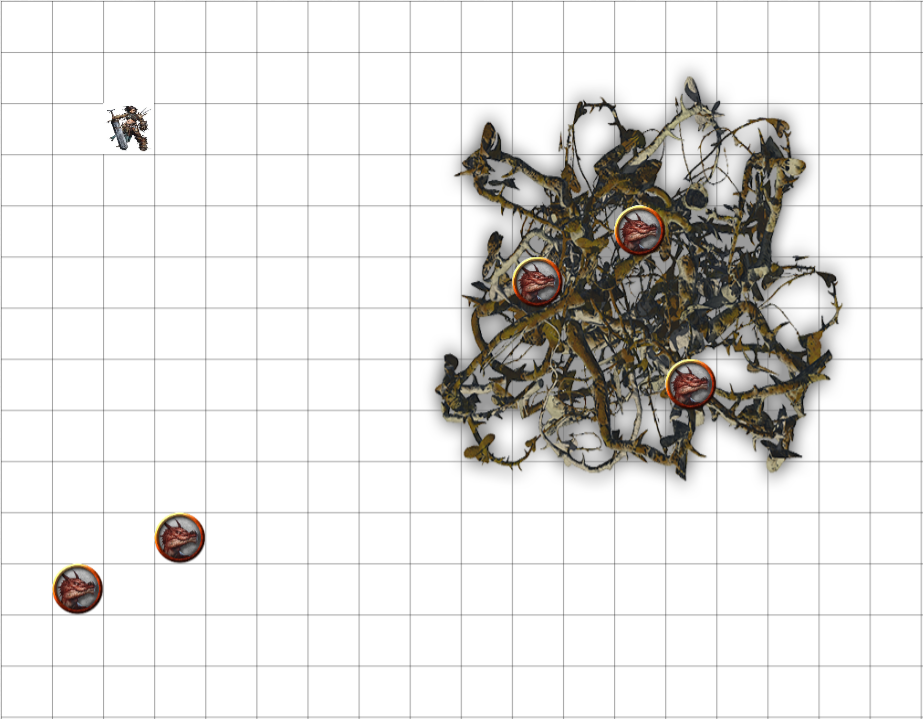
There’s no reason that you can’t just drop a Spike Growth on top of some or all of your enemies. This is a great way to guarantee that you squeeze a few points of hp out of the enemy while you slow their advance.
In the picture above, the ranger is being attached by two groups of kobolds. She opts to slow down half the group by placing Spike Growth directly on top of the larger group. She now has time to deal with the two remaining kobolds while the others trudge through the thorns and spikes and take some chip damage.
This is an effective tactic to use in large, open spaces. It allows you and your party to focus on a smaller amount of enemies which in turn means that you will take less damage from the encounter than the DM probably planned. You’ve effectively broken up a medium encounter into two easy encounters.
Use as a Blockade
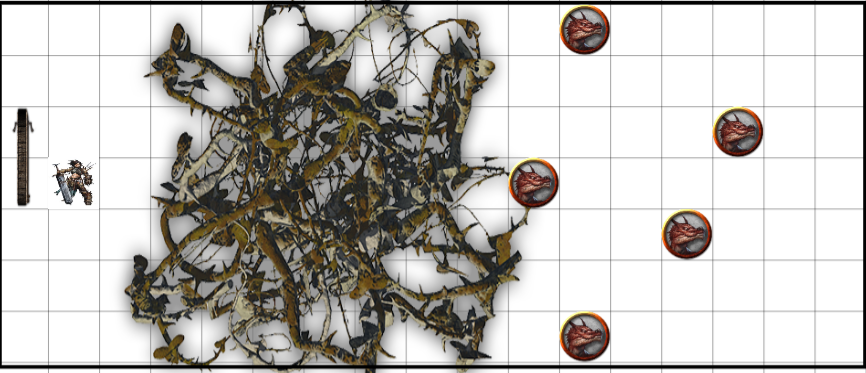
In this scenario, the ranger is in a room and is looking to retreat from the swarm of kobolds. Luckily, she is near the exit, but she is looking to ensure that her escape is a success.
To buy herself and her party some extra time she decides to cast Spike Growth and fill the area between herself and the enemy with difficult terrain and sharp thorns that the enemy will need to trudge through.
The kobolds now need to make a choice. Do they make Sling attacks at the ranger at disadvantage, or do they trudge through and take damage to get into a more opportune position? Either way, it’s a win-win for the ranger and gives her enough leeway to make it out of the encounter and regroup with her allies.
You could also drop Spike Growth directly onto the group of the kobolds in this scenario. However, positioning the spiky terrain between yourself and the kobolds widens the gap between both groups, meaning that you can buy yourself some additional time if they choose to chase after you.
Using Wall Spells like Wall of Fire
Wall spells are spells that will create a physical barrier or wall that you can place on the battlefield. These spells have specific dimensions that each wall or barrier must abide by. Each of these spells functions differently, either by placing a sturdy barrier that cannot be crossed or placing a barrier that can be crossed but a creature that does so will suffer consequences.
Essentially, you create an obstacle that a creature must either use some of their action economy to resolve and/or sacrifice health or movement to pass through it.
Walls do have the downside of not providing much of a threat to aerial combatants, but otherwise, they are solid obstacles to help you control the battlefield.
Wall of Fire creates a wall of flames that is 60 ft. long, 20 ft. high, and 1 ft. thick. It can also be conjured as a ring of fire that is 20 ft. in diameter, 20 ft. high, and 1 ft. thick. Any creature that is within the wall’s area has to immediately make a Dexterity saving throw or take 5d8 fire damage with half as much on a success.
After that, you decide which side of the wall deals damage. Any creature that passes through that side of the wall or ends their turn within 10 ft. of the wall on that side or inside of it will take the 5d8 fire damage. The other side of the wall deals no damage to anyone, making it a safe area for your allies.
Halt Their Advance (or Retreat!)
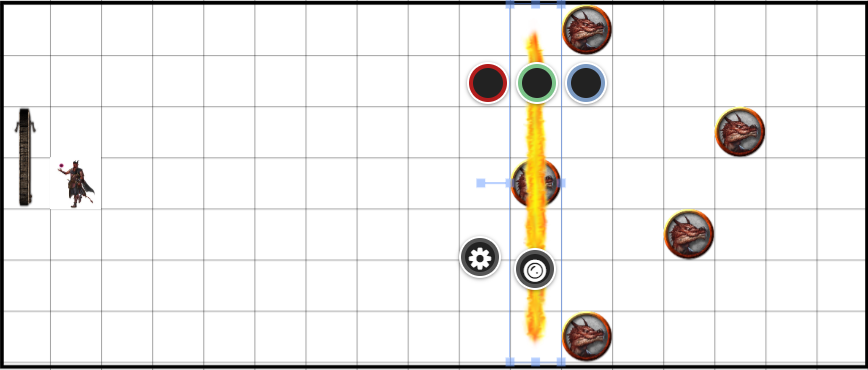
This is a tactic that you can use to either prevent the enemy from advancing or retreating. In this scenario, the warlock is overwhelmed by a group of kobolds and has decided to try and dissuade the kobolds from continuing their advance.
The sorcerer drops the Wall of Fire directly on top of one of the kobolds so that one will certainly be taking some damage. The wall is also in a position to immediately impact two kobolds should they choose to hold their ground on their next turn.
Now that the wall is placed, the sorcerer can now rush out the door and regroup with his allies. He could also instead choose to stand his ground and finish off the weakened kobolds that have run through the flames.
Break the Enemy Formation
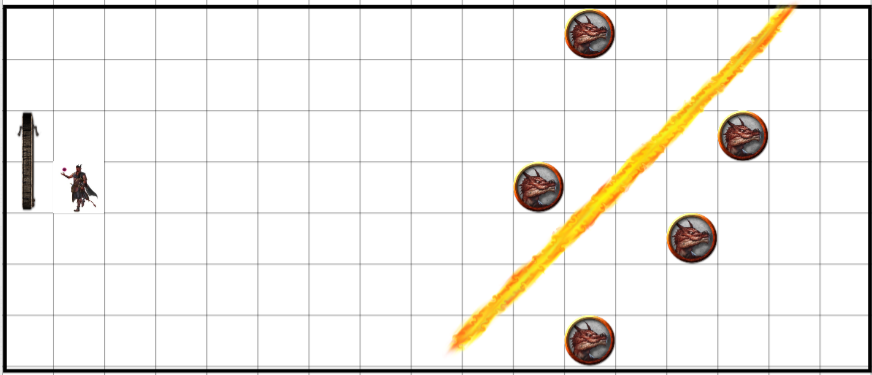
Walls can also be used as barriers for separating a group. In this scenario, the sorcerer is confident that he can take on the group of kobolds, but he wants to make things easier by separating the group.
The first group of kobolds can rush at him, but that’s ok because he knows he can handle their reduced numbers. The second portion of the group is still able to advance, but in doing so they’ll take a sizeable amount of damage from the flames.
The flames are an obstacle that will force the enemy to take a risk or sacrifice their allies if they refuse to.
This tactic is not the most optimal way to use Wall of Fire, but there are other wall spells such as Wall of Ice that would work considerably better with this tactic. This is still a potentially effective way to slow down the enemy or potentially force them to delay their advance until the wall is dropped, but I’d argue that the dropping Wall of Fire on top of a few of the kobolds is the better play.
Conclusions
While this is a D&D 5e-focused article, the general concept of battlefield control can translate to any TTRPG with combat. These exact tactics can also work in any TTRPG with spells or similar abilities so keep that in mind as well.
Walls and area of effect control spells are fun spells to use to keep yourself and your allies safe while also costing the enemy precious resources such as health or their action economy.
By having battlefield control your party has more room to move around and position while preventing the enemy from having the same benefits. The benefit is not as easily calculated as healing or damage dealing, but it’s still a tangible benefit in combat!
